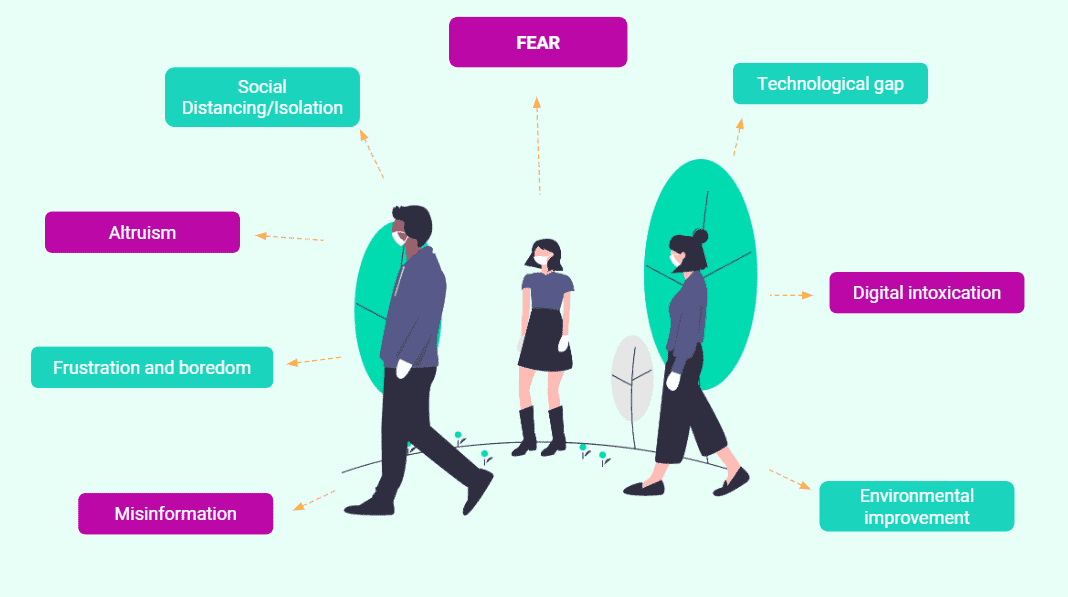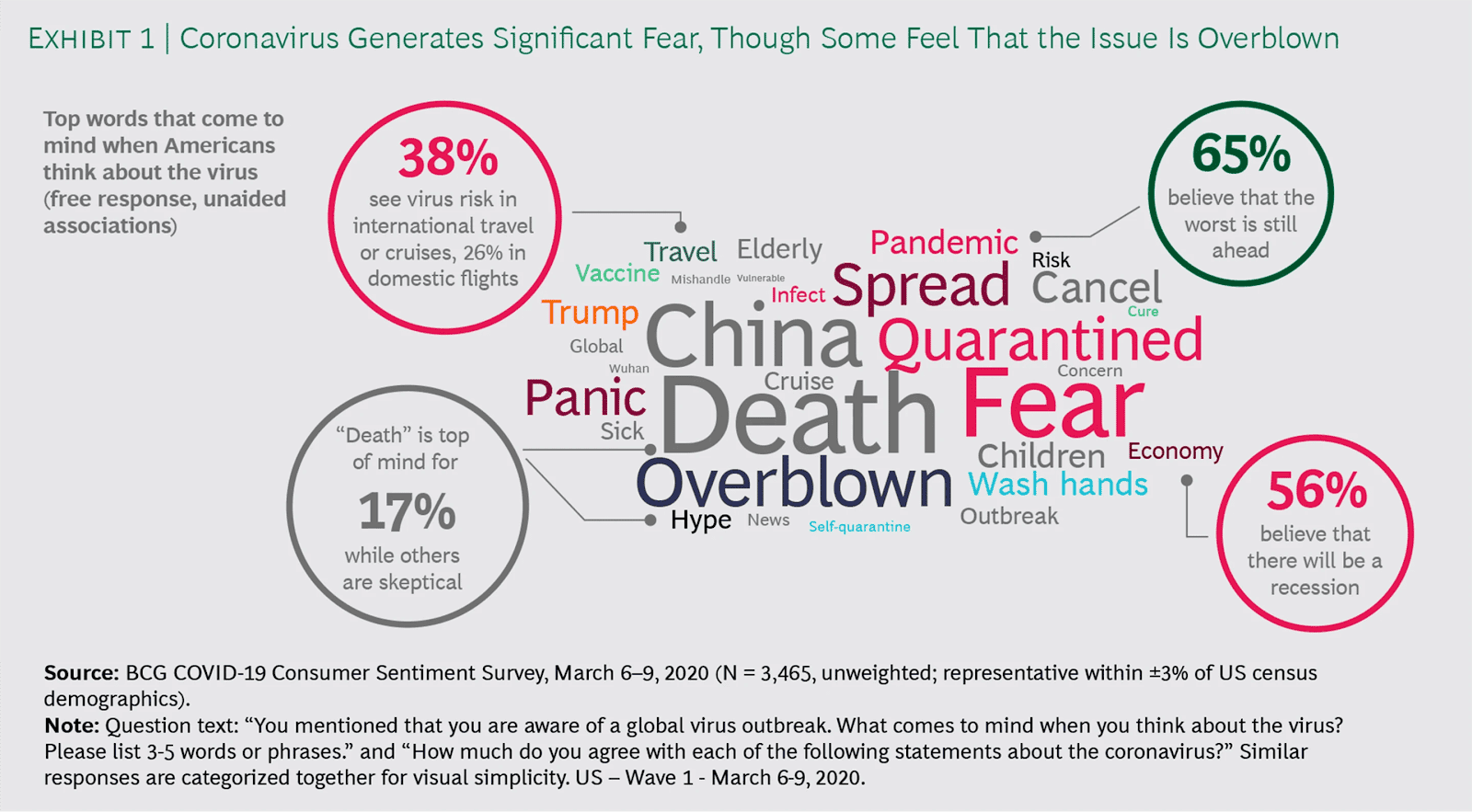The world on pause. One day we had to stop. We had to drastically modify our way of life and there may be changes that will continue even when the pandemic is over. What is certain is that for a long time our feelings, emotions and behaviors have been modified. That is why we have to understand and get used to the NEW NORMAL.
With these shifts in consumer behavior changes, brands should ask themselves:
How can we stay relevant to what our customers want in the new normal?
To understand and capitalize on these behavioral changes and translate them into their products and services will be the ones who achieve a lasting and positive impact on their consumers. Brands must be flexible and adapt to change. They should ask themselves how they will add value to this new reality.
There are many ways in which they can improve people’s lives in this context of crisis and in what will be the “new normal”, and it will be those who generate relationships with their users in an appropriate way, the ones who will be able to transcend.
Let’s understand these new behaviors and emotions

Fear
The first feeling that seized us was fear. Fear not only of the disease, which translates into fear of traveling, of massive events, of daily activities, fear of the other. But also fear of the economic recession whose implications are still unknown. Fear of personal finances and fear of losing a job. As a consequence, these fears are clearly reflected in consumer’s changes habits.
Changes are already being reported in consumption habits and are expected to continue for the next 6 months. The winners of this crisis will be organic food, preventive medicine, and education. On the contrary, those who will see a greater depression will be everything related to pleasure, travel, luxury, recreational activities, tobacco, and gambling.

A BCG research revealed that many US consumers believe that “the world is in serious danger” due to the virus (46% of consumers surveyed). That “there will be a recession” (56% of consumers), and that “the worst impacts are ahead” (65% of consumers).
Social distance. Isolation
Now once we overcome the fear, let’s analyze the other behavioral changes that are happening now:
Social distancing carries a number of consequences and changes. From the need to feel connected to the loved ones, to much more practical issues of daily life, such as assisting the elders with their healthcare needs, food, etc. Indeed, we are talking about behavioral changes.
In China, for example, the adult population (who previously had no close relationship with technology) has adopted many digital services to stock up on groceries and similarly. They have been ordering medicine and consulting doctors via health apps during the crisis.
Meituan, one of China’s largest delivery platforms, reported orders for medication related to chronic diseases including high blood pressure, diabetes, and arthritis increased by over 200% during the Spring Festival.
We should be asking ourselves:
As a brand, how am I helping to reduce this distance? How am I delivering my product/service in this context of isolation?
Frustration and boredom
This social isolation, in addition to practical issues, carries feelings of frustration and boredom.
“At this moment in time, we’re not just combating the coronavirus, but we’re combating fear and anxiety and social isolation as well,” Bill Walsh, vice president of communications at AARP, told Recode. “So it’s important to stay in touch with your loved ones and let them know that they haven’t been cut off or somehow marginalized.” Reference
Isolation also brings “its own devastating health effects. A study by the AARP compared the effects of prolonged isolation to those of smoking 15 cigarettes a day”. Reference
The need for physical contact, the need to see a “real face”, carries enormous frustration. In China, it has also been detected an increase in the usage of apps related to entertainment in the adult population. These people were very far from these apps three months ago.
Altruism
As a society, it seems that we are understanding that we must come out of this crisis together. We should help others, create networks and assist the most vulnerable. The feeling of altruism is present in a large part of society.
A large number of initiatives, both physical and digital, have emerged to build collaboration in the middle of this pandemic. Not only in medical aspects but also in everyday life.
The coronavirus is the most urgent transnational, cross-demographic problem in recent history. It will remind people that the best organizations collaborate generously with others. Reference
Just as in 1959 Volvo invented the three-point seat belt and became famous for making the patent available for the sake of public safety. We should ask ourselves:
What can we do as a brand to collaborate with society and be remembered in the future?
Misinformation
Like in all other crises and emergencies, the uncertainty that we are living helps to propagate mis- and disinformation across the internet. Reference
We have seen lots of ridiculous news and posts regarding cures for the illness. This includes some from credible sources, for instance. “The CVS Health chief medical officer sent an email to it’s 300,000 employees apparently parroting information found in the viral social media post. Drinking warm water is an effective way to wash the virus into your stomach, where it’s killed, the email stated.”
So every brand should take this seriously. They should think what is their contribution to stop misinformation and share useful information for their customers.
Some websites like Pinterest have re-routed searches for “coronavirus” to fact-based posts from “internationally-recognized health organizations,”. And Twitter is removing tweets with COVID-19 misinformation that could cause physical harm. As they explained they are adjusting their content moderation capacities. But right now, they are focusing on content that has the highest potential of directly causing physical harm,” the company tweeted. Reference
Just as these large companies are developing strategies to mitigate misinformation. Each brand should analyze its own communication strategy to add value in this regard:
How are we informing our users? What tools are we going to use to avoid misinformation?
Technology Gap
“The quarantines have encouraged the aging population to use apps to meet various needs in life.” Reference
This pandemic finds us with much better tools than any other humanitarian crises in the past. These tools to communicate, entertain and to satisfy basic needs. However, the adult population, the most vulnerable and those most in need of these services, still suffer from this technological gap.
Some companies like GrandPad tablet are making the process of video calling and sharing photos much easier for this population. Others have been working in the last years on improving their experiences to adapt to the adult population.“The user experience for services like Amazon Fresh, Instacart, Fresh Direct, and Peapod has gotten much better in recent years, even for the technology-challenged,”. Reference
If we are willing to satisfy the needs of this age range with our product or service:
Are we really considering their needs and difficulties? Are we taking into account the learning curve required for them?
Digital Intoxication
With social isolation, we turn to digital devices much more than ever. For many people, their only contact with the outside world is a screen. We consume information at all times and we communicate with people with whom we have not interacted for years. Also, we use all kinds of applications and devices to have fun, stock up and communicate.
But like everything else, this also involves saturation, fatigue, intoxication with everything related to a screen. In this context, we must be extremely careful in how we manage the communications and interactions of our users with our brand in the new normal. Therefore, on the one hand, we don’t oversaturate them, but on the other, we keep in contact and continue building a relationship.
In this moment we should ask ourselves:
Are we adding value or are we forcing our customers to interact with our brand without any useful purpose?
Environmental improvement changes
The extreme decrease in human activity has given the planet some space to breathe. Reference
We have seen Venice canals turn crystal clear amid COVID-19 nationwide lockdown, as well as China replaces smog with blue skies. There are images from the NASA and European Space Agency pollution monitoring satellites. They show a significant decrease in nitrogen dioxide levels in the air.
Everywhere social media users are pointing to signs of environmental progress as a hopeful prospect amid the viral pandemic.
However, this is temporary, we must think about how we are going to take this opportunity to sustain these improvements in the long term.
For example, some US Democrats are demanding that Trump put conditions on greenhouse gas emission at the forefront of any financial aid deal with US airlines. “If we give the airline and cruise industries assistance without requiring them to be better environmental stewards, we would miss a major opportunity to combat climate change and ocean dumping,” the letter reads. Source
We must rethink our strategy for the future:
How are we going to take advantage of this moment to collaborate with this environmental improvement? How are we going to continue taking actions that reduce pollution?
This is an unbeatable opportunity.
Re Imagination
A shock of this scale will create a discontinuous shift in the preferences and expectations of individuals as citizens, as employees, and as consumers.
These shifts and their impact on how we live, how we work, and how we use technology will emerge more clearly over the coming weeks and months in the new normal.
Organizations that reinvent themselves to make the most of better insight and foresight, as preferences evolve, will disproportionately succeed. Reference
Brands who are willing to be actively present can emerge from this challenging period of behavior change with stronger brands and a more committed, trusting fan base – so when things eventually settle to the next new normal, brand growth can be sustained.
We are navigating to a new normal. A normal that looks unlike any in the years preceding the coronavirus, the pandemic that changed everything.
This post is part of the Continuity initiative by Globant. This aims to help organizations in this crisis, to guarantee their business continuity.





